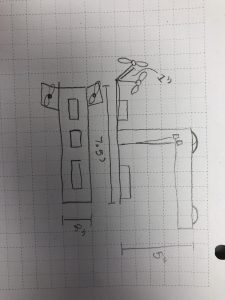Concept Screening Matrix:
| Criteria | reference | Rylee | Tyler | Alex | Celia | Team |
| weight | 0 | 0 | 0 | -1 | 1 | 0 |
| resistance | 0 | 0 | 1 | 0 | 1 | 0 |
| maintanence | 0 | -1 | -1 | 0 | -1 | -1 |
| cost | 0 | 1 | 1 | -1 | -1 | 0 |
| balance | 0 | 0 | 0 | 0 | 0 | 0 |
| adaptability | 0 | 1 | 0 | 1 | 0 | 0 |
| durability | 0 | 0 | 0 | 0 | 0 | 0 |
| num + | 0 | 2 | 2 | 1 | 2 | 0 |
| num 0 | 7 | 4 | 4 | 4 | 3 | 6 |
| num – | 0 | 1 | 1 | 2 | 2 | 1 |
| net | 0 | 1 | 1 | -1 | 0 | -1 |
| continue | no | yes | yes | no | no | revise |
Concept Scoring Matrix:
| reference | Rylee | Tyler | Team | ||||||
| Criteria | weight | rating | weighted score | rating | weighted score | rating | weighted score | rating | weighted score |
| weight | 30% | 2 | 0.6 | 2 | 0.6 | 4 | 1.2 | 3 | 0.9 |
| resistance | 5% | 3 | 0.15 | 3 | 0.15 | 3 | 0.15 | 3 | 0.15 |
| maintanence | 10% | 3 | 0.3 | 3 | 0.3 | 2 | 0.2 | 2 | 0.2 |
| cost | 30% | 2 | 0.6 | 4 | 1.2 | 3 | 0.9 | 1 | 0.3 |
| balance | 5% | 2 | 0.1 | 3 | 0.15 | 3 | 0.15 | 2 | 0.1 |
| adaptability | 10% | 3 | 0.3 | 4 | 0.4 | 2 | 0.2 | 3 | 0.3 |
| durability | 10% | 2 | 0.2 | 2 | 0.2 | 2 | 0.2 | 3 | 0.3 |
| total score | 2.25 | 3 | 3 | 2.25 | |||||
| continue? | no | yes | yes | no |
The criteria for the designs were weight, resistance, maintenance, cost, balance, adaptability, and durability. Weight is how much the design weighs. Resistance is the air resistance that results from the design. Maintenance is how easy it is to keep the design between trials and labs. Cost is how much the AEV design parts cost in total. Balance is how the design balances on the AEV track. Adaptability is how easy it is to change the design for performance improvement. Lastly, durability is how strong the design is. The spreadsheet shows how each of the designs compare with the sample AEV given to the team.
Individual concept Sketches:
Alex’s design also has a lot of space on its surface to adapt the design but it would be heavier and cost more than the sample AEV.
Celia’s design was lighter and more narrow than the sample design which means that there would be less resistance, but it would also cost more and be harder to maintain with the same battery problem as the others.
Compared to the sample AEV given to us, Rylee’s design was more adaptable since it had a lot of versatility with extra space on its surface and it cost less than the sample AEV. However, since the battery had to be attached and detached everytime with screws, it would be hard to maintain.
Tyler’s design was narrower than the sample AEV so there would be less air resistance and it also cost less than the sample AEV, but similar to Rylee’s design, it would be hard to maintain with the battery.
Team concept Sketch:
The team concept sketch had a very design to the reference AEV given to the team. As a result, in the screening matrix, the net score was zero because there was not a major difference between the reference AEV and the team concept sketch.
After going through all the pros and cons of each design, the team decided to go forward with Rylee’s and Tyler’s design.




